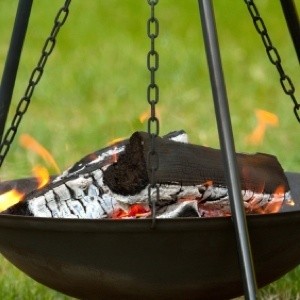
If your house is equipped with a wood-burning fireplace or you have a fire pit in your backyard, put the left over ashes to work in the garden. As long as you follow a few simple precautions, wood ashes can be used to benefit the garden in three ways: as a fertilizer, as a soil amendment, or as an insect repellent.
As a fertilizer, wood ashes are a good source of potassium, phosphorus, magnesium, and aluminum. They typically contain less than 10% potash, 1 % phosphate, and trace amounts of micro-nutrients such as iron, manganese, boron, copper, and zinc. (Wood ashes do not contain nitrogen.) The exact chemical make-up of ashes varies according to wood type (hardwood ashes contain higher potassium levels than softwood ashes). If compared to a commercial fertilizer, wood ashes would probably read about 0-1-3 (N-P-K).
Wood ashes contain approximately 25% calcium carbonate and behave like a liming agent when added to your soil (raises the pH). Because ashes are soluble in water, they can quickly correct pH levels when added to acidic soil (pH less than 5.5).
If you're unsure of your soil's pH, don't add wood ashes to your soil until you have it tested. Raising the soil's pH above optimum levels can adversely affect the health of your plants. When pH levels rise above 7.0 (neutral), important nutrients like phosphorus, iron, boron, and potassium start to chemically bond to the soil and become less available to plants.
Because of its ability to absorb water, wood ashes can also be sprinkled around plants to prevent attacks from snails and slugs. Once wet, the ashes lose their effectiveness and must be reapplied. To avoid causing chemical burns to your plants, sprinkle small amounts of ashes evenly around the base of the plant, and rinse off any that comes in contact with the foliage.
Handling & Storage
Ashes from charcoal grills should never be used in the garden due to the chemical residues left by processed charcoal. The same is true of ashes obtained from cardboard, and ashes from wood that has been pressure-treated, painted, or stained. All contain harmful chemicals that could potentially contaminate soil and inhibit plant growth.

About The Author: Ellen Brown is an environmental writer and photographer and the owner of Sustainable Media, an environmental media company that specializes in helping businesses and organizations promote eco-friendly products and services.
Add your voice! Click below to comment. ThriftyFun is powered by your wisdom!
Our contractor swears by putting wood dust in the flower beds. I tried a little last year, but couldn't tell the difference. Doesn't mean it doesn't work, of course, but ...
Add your voice! Click below to comment. ThriftyFun is powered by your wisdom!